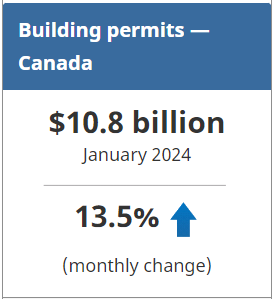Statistics Canada: Building Permits, January 2023

Month over month, the total value of building permits in Canada rose 13.5% in January to $10.8 billion, rebounding after a decrease of 11.5% in December. The residential sector increased 12.6% to $6.5 billion in January, while the non-residential sector grew 14.8% to $4.2 billion.
On a constant dollar basis (2017=100), the total value of building permits was up 14.0% to $6.7 billion in January.
Housing intentions in Ontario lead overall gains in residential sector
The total monthly value of residential permits increased 12.6% to $6.5 billion in January, following a weak December.
Gains in the residential sector in January were led by a strong rebound in multi-unit construction intentions (+35.1% to $4.0 billion), and Ontario (+29.1% to $1.4 billion) led this increase. Specifically, multi-unit permits were concentrated in the census metropolitan areas of Toronto, Kitchener–Cambridge–Waterloo and London. Quebec (+61.6%; +$244.7 million) and British Columbia (+36.7%; +$281.9 million) also posted notable gains in multi-unit permit values.
The overall residential growth in January was tempered by a decline in the total value of single-family dwelling permits (-10.3% to $2.6 billion), with declines occurring in nine provinces.
Across Canada, 15,200 new dwellings in multi-unit buildings and 4,000 new single-family dwellings were authorized in January.
Commercial projects in Quebec spark non-residential growth
The total monthly value of non-residential permits increased 14.8% to $4.2 billion in January, following a 4.0% decline in December.
The growth was attributed to the commercial component, which increased 34.5% to $2.3 billion, the highest monthly level recorded since April 2023. A $200 million permit for a new data centre in Lévis, Quebec, greatly contributed to the growth observed in January 2024.
To explore data using an interactive user interface, visit the Building permits: Interactive Dashboard.
For more information on construction, please visit the Construction statistics portal.
For more information on housing, please visit the Housing statistics portal.
To view the original post, click here.
Note to readers
Unless otherwise stated, this release presents seasonally adjusted data with current dollar values, which facilitate month-to-month and quarter-to-quarter comparisons by removing the effects of seasonal variations. For information on seasonal adjustment, see Seasonally adjusted data – Frequently asked questions.
Building components
- Single-family dwellings: Residential buildings containing only one dwelling unit (e.g., single-detached house, bungalow, linked home [linked at the foundation]).
- Multi-family dwellings: Residential buildings containing multiple dwelling units (e.g., apartment, apartment condominium, row house, semi-detached house).
- Industrial buildings: Buildings used in the processing or production of goods or related to transportation and communication.
- Commercial buildings: Buildings used in the trade or distribution of goods and services, including office buildings.
- Institutional and government buildings: Buildings used to house public and semi-public services, such as those related to health and welfare, education or public administration, and buildings used for religious services.
Revision
Data are subject to revisions based on late responses, methodological changes and classification updates. Unadjusted data have been revised for the previous month. Seasonally adjusted data have been revised for the previous three months.
For information on trend-cycle data, see the page Trend-cycle estimates – Frequently asked questions.
Next release
Data on building permits for February will be released on April 10.
Source: Statistics Canada


